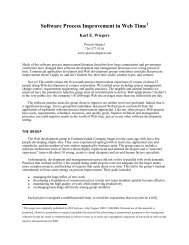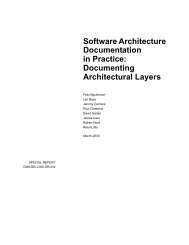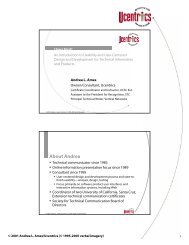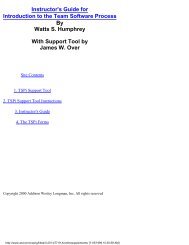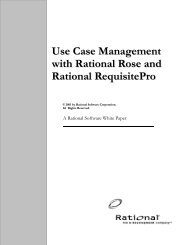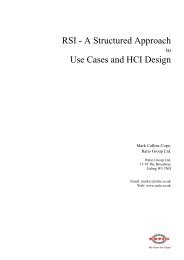Using Data Modeler
Using Data Modeler
Using Data Modeler
Create successful ePaper yourself
Turn your PDF publications into a flip-book with our unique Google optimized e-Paper software.
UML and <strong>Data</strong> Modeling2ContentsThis chapter is organized as follows:■UML Introduction on page 5■Why UML for <strong>Data</strong> Modeling? on page 5■Advantages of Rose UML and <strong>Data</strong> Modeling on page 7UML IntroductionTeams need one tool, one methodology, and one notation. Since its inception, theUnified Modeling Language (UML) has been unifying members of a developmentteam for faster and higher quality applications. But UML allowed only businessanalysts and application designers to communicate with each other, databasedesigners were excluded because they used a different kind of notation. Rose adds aUML profile to accommodate entity/relationship (E/R) notation with the addition of<strong>Data</strong> <strong>Modeler</strong>, allowing the database designer to communicate with the businessanalyst and application designer, making the UML a truly unifying language.Why UML for <strong>Data</strong> Modeling?The UML offers a standard notation very similar to Peter Chen’s E/R notation. LikeChen’s E/R the UML is based on building structures using entities that relate to oneanother. By adding the data modeling profile, UML’s ability to model an entire systemis increased, allowing you to model not only logical models, but physical data modelstoo, mapping your applications and your databases.<strong>Data</strong> Modeling Profile Added to UMLA UML profile is an Object Management Group (OMG) approved method of addingto UML for a specific subject, without altering the UML metamodel. UML profilesadded to UML use customized stereotypes and tagged values based on their subject’sconcepts and terminology.5



